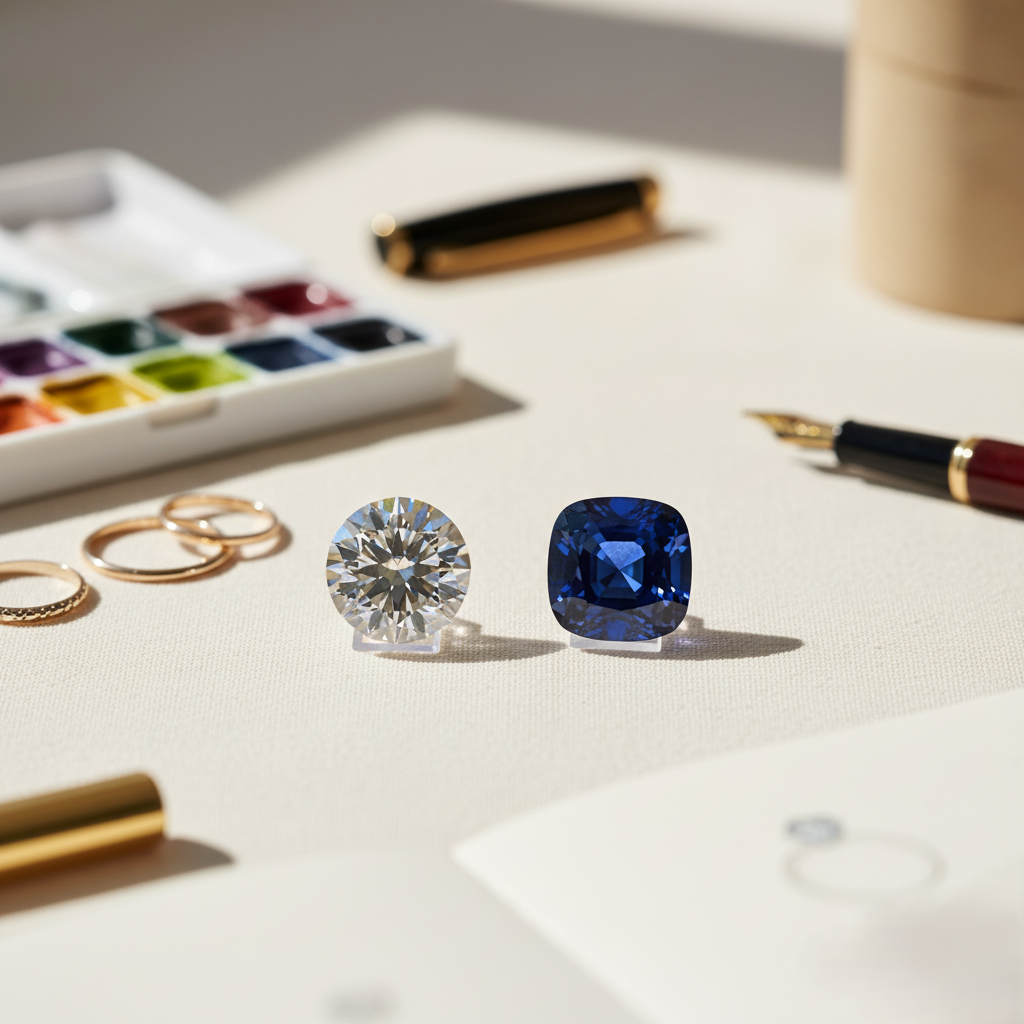
Diamonds vs. Sapphires: Choosing Your Engagement Ring Gemstone
Share
An engagement ring is the first chapter in a new family’s story, a tangible piece of a legacy waiting to be written—the first modern heirloom. The choice of its central gemstone is the heart of this narrative, a decision that reflects the unique character of a couple’s bond. For generations, the diamond has stood as the icon of timeless brilliance, while the sapphire has long been the emblem of regal history and unique personality . Deciding between these two legendary stones is a journey of discovering which gem best tells your personal love story.
The Diamond: A Legacy of Unwavering Brilliance
The diamond’s position as the quintessential engagement stone is built on a foundation of unparalleled physical properties and potent symbolism . Its story is one of permanence and light, making it the enduring choice for a symbol of lifelong commitment.
The Pinnacle of Durability
A diamond’s legendary durability is scientifically quantifiable, scoring a perfect 10 on the Mohs scale of hardness, which measures resistance to scratching . As the hardest natural substance on Earth, a diamond offers unmatched protection against the scuffs of daily life . It is important to distinguish hardness (scratch resistance) from toughness (resistance to chipping). While very tough, diamonds can chip if struck with force at a specific angle. They also possess excellent chemical stability, ensuring their beauty remains constant through the years.
The Language of Light
A diamond's captivating sparkle is a result of its interaction with light, which is broken down into three components :
- Brightness The white light reflected from the diamond.
- Fire The dispersion of light into flashes of rainbow color.
- Scintillation The play of light and dark areas that creates a dynamic sparkle.
Of all factors, the cut is most critical in unlocking this performance . An expertly cut diamond can appear more brilliant and larger than a poorly cut stone of a higher carat weight, making cut the most important investment in a diamond’s beauty.
Decoding the 4Cs
The Gemological Institute of America (GIA) established the 4Cs—Cut, Color, Clarity, and Carat Weight—as the universal standard for assessing diamond quality .
- Cut The most important "C" for beauty, graded from Excellent to Poor based on how well the diamond interacts with light.
- Color Refers to the absence of color, with the GIA scale running from D (colorless) to Z (light yellow/brown). Diamonds in the H-J range often appear nearly colorless and offer excellent value.
- Clarity Measures the absence of internal 'inclusions' and external 'blemishes.' Many diamonds in the VS2 to SI1 range are "eye-clean," meaning their minor inclusions aren't visible without magnification.
- Carat A measure of weight, where one carat equals 200 milligrams. Price increases dramatically with carat weight due to rarity.
While this system provides security, its standardization can diminish the sense of personal discovery that some couples seek, opening the door to the unique appeal of colored gemstones.
The Sapphire: A Spectrum of Regal Personality
For centuries, the sapphire has been the jewel of royalty, prized for its rich color, noble history, and enduring strength . It offers a world of personalization, allowing a ring to become a vibrant expression of its wearer’s identity.
An Enduring Royal Favorite
The sapphire’s resilience is proven by its place in history's most significant jewelry collections. It scores a 9 on the Mohs scale, making it second only to the diamond in hardness and an exceptionally durable choice for an engagement ring. This strength, seen in royal heirlooms worn for generations, makes it more than capable of withstanding daily life . Like diamonds, sapphires have excellent chemical stability and can be cleaned safely, though warm, soapy water is always a reliable method.
A World of Color
The sapphire's most captivating quality is its breathtaking range of colors. While classic blue is the most famous, sapphires (part of the corundum mineral family) come in a full rainbow of options known as "fancy sapphires." These include romantic pinks, joyful yellows, lush greens, and the rare Padparadscha, a delicate pink-orange blend . This diversity allows a couple to choose a stone that reflects a favorite color, a birth month, or a specific personality trait: blue for loyalty, pink for romance, or a modern teal for a unique statement.
Understanding Sapphire Quality
Unlike the standardized 4Cs for diamonds, sapphire quality is evaluated through a more nuanced lens where a jeweler's expertise is paramount.
- Color is King This is the most important factor, judged on hue (primary color), tone (lightness/darkness), and saturation (intensity). The most valuable sapphires have "strong" to "vivid" saturation.
- Clarity Natural sapphires are expected to have some inclusions; the benchmark is being "eye-clean," with no inclusions readily visible to the naked eye.
- Cut A sapphire is cut primarily to enhance its color, displaying its best hue while retaining as much carat weight as possible.
This lack of a single grading standard transforms the jeweler into an expert guide, essential for finding a truly exceptional stone.
The Definitive Comparison
A direct comparison can help couples align their priorities with the perfect gemstone.
| Feature | Diamond | Sapphire |
|---|---|---|
| Hardness (Mohs Scale) | 10 (The hardest natural material) | 9 (Extremely durable and suitable for everyday wear) |
| Primary Aesthetic | Unmatched brilliance, fire, and scintillation (sparkle) | Rich, saturated color in a variety of unique hues |
| Color Options | Primarily colorless; fancy colors are rare and expensive | Full spectrum: blue, pink, yellow, green, teal, etc. |
| Key Quality Factor | Cut (Drives its beauty and sparkle) | Color (Drives its beauty and value) |
| Symbolism | Eternal love, strength, unwavering commitment | Loyalty, wisdom, faithfulness, royalty |
| Average Price (1-Carat) | Higher: Approx. $5,000–$30,000+ | Lower: Approx. $500–$5,000+ |
| Value Proposition | Investment in timeless tradition and maximum sparkle | Investment in unique personality and a larger stone for the budget |
A diamond's sparkle is iconic, but a sapphire offers a compelling value proposition: for a given budget, a couple can typically acquire a much larger and more visually impactful sapphire than a diamond.
Styling Your Story: Modern Trends
Today's engagement ring landscape is more personalized than ever, with a significant shift towards colored gemstones driven by a desire for unique self-expression.
Celebrity rings often set trends. The enduring appeal of Kate Middleton's royal sapphire ring continues to inspire , while recent diamond rings worn by Taylor Swift (vintage-inspired) and Zendaya (contemporary East-West setting) showcase the stone's versatility.
Current top styles embrace both gems:
- Three-Stone Rings Symbolizing the past, present, and future, this style is seeing a resurgence, allowing for a mix of diamonds and sapphires.
- Toi et Moi ("You and Me") This romantic style features two main stones side-by-side, perfect for uniting a diamond and a sapphire to symbolize two individuals .
- Yellow Gold The warm tone of yellow gold creates a beautiful contrast with both deep blue sapphires and brilliant diamonds.
- Bezel Settings & Bold Bands These modern, architectural styles offer excellent protection for any gemstone and make a strong, confident statement.
Find Your Forever Stone
The choice between the eternal fire of a diamond and the colorful soul of a sapphire is deeply personal. The diamond speaks of an unbreakable promise, while the sapphire tells a tale of individuality . This decision is the first step in creating a modern heirloom, defined by its significance, quality, and timeless design. Whether your future is envisioned in the sparkle of a diamond or the vibrant hue of a sapphire, the perfect stone to begin your forever awaits.
